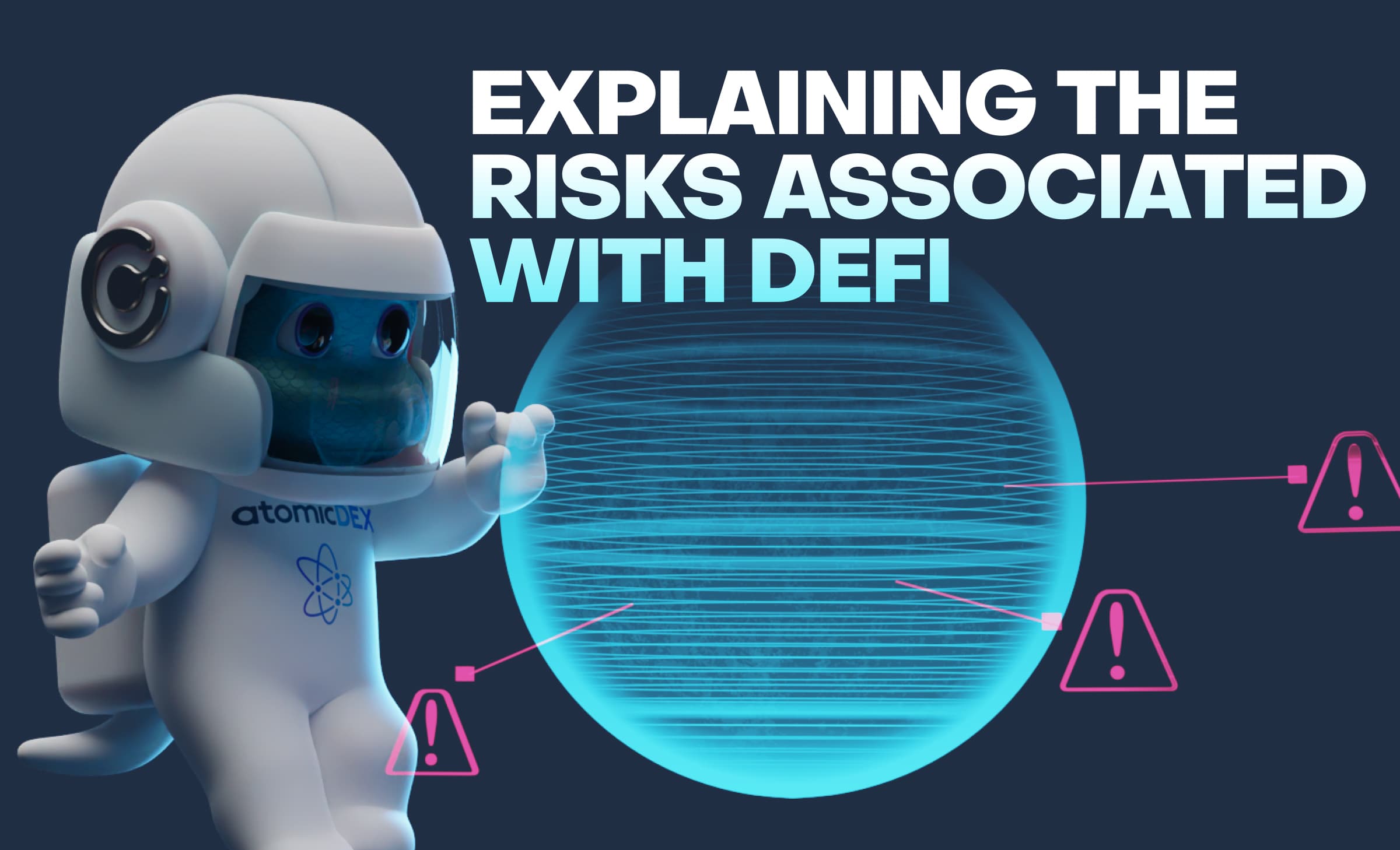
Table of contents
- Definition of DeFi and Its Growing Popularity
- Risks Associated with Smart Contracts in DeFi Applications
- Vulnerabilities and Exploits to Watch Out for in DeFi Platforms
- Understanding Market Risks in Decentralized Finance
- Recognizing and Avoiding Scams in DeFi: The Rug Pull Phenomenon
- Impermanent Loss: A Potential Risk for Liquidity Providers in Decentralized Exchanges (DEXs)
- Conclusion
- Try AtomicDEX — Ultimate DeFi Wallet
Table of contents
- Definition of DeFi and Its Growing Popularity
- Risks Associated with Smart Contracts in DeFi Applications
- Vulnerabilities and Exploits to Watch Out for in DeFi Platforms
- Understanding Market Risks in Decentralized Finance
- Recognizing and Avoiding Scams in DeFi: The Rug Pull Phenomenon
- Impermanent Loss: A Potential Risk for Liquidity Providers in Decentralized Exchanges (DEXs)
- Conclusion
- Try AtomicDEX — Ultimate DeFi Wallet
Decentralized finance, commonly known as DeFi, is one of the most transformative and rapidly growing sectors within the cryptocurrency industry.
It offers individuals unprecedented financial freedom, allowing them to engage in various financial activities without the need for intermediaries like banks or traditional financial institutions.
As the popularity of DeFi continues to soar, it is essential to understand the risks associated with this emerging ecosystem.
Definition of DeFi and Its Growing Popularity
DeFi refers to a set of financial applications built on blockchain networks that aim to provide open and permissionless access to financial services. Popular DeFi blockchain protocols include Ethereum, Avalanche, and Fantom, among others. DeFi use cases include lending and borrowing, decentralized exchanges, yield farming, and more. DeFi has gained immense popularity due to its potential to democratize finance, eliminate market participation barriers of traditional finance, and provide greater financial access to anyone with an internet connection.
While DeFi presents exciting possibilities, it is not without risks. It is crucial for participants to be aware of these risks and take necessary precautions.
Some of the common risks associated with DeFi include smart contract vulnerabilities, exploits, market risks, scams, and impermanent loss for liquidity providers.
Risks Associated with Smart Contracts in DeFi Applications
Smart contracts are self-executing contracts with the terms and conditions of the agreement directly written into lines of code. They play a vital role in DeFi applications by automating financial transactions, removing intermediaries, and ensuring transparency. However, smart contracts are not immune to risks.
Code vulnerabilities, hacks, and bugs are significant risks associated with smart contracts in DeFi. Mistakes in the code or security vulnerabilities can be exploited by malicious actors, leading to the potential loss of funds. Several high-profile cases, such as the infamous The DAO hack and the Parity wallet bug, have highlighted the need to implement rigorous code auditing and strong security measures in DeFi.
Vulnerabilities and Exploits to Watch Out for in DeFi Platforms
DeFi protocols are susceptible to various types of exploits and vulnerabilities. These include flash loan attacks, oracle manipulation, reentrancy attacks, and governance attacks. Exploits can result in substantial financial losses and undermine users' confidence in the DeFi ecosystem.
Examples of successful DeFi exploits and vulnerabilities are plentiful. In 2020, the notorious "YAM" protocol saw a vulnerability in its rebasing mechanism that caused a loss of funds for users. Similarly, the "bZx" protocol suffered from multiple attacks that allowed attackers to exploit the lending platform and manipulate crypto prices.
Understanding Market Risks in Decentralized Finance
Market risks pose significant challenges to DeFi participants. The inherent volatility of cryptocurrencies and the potential for liquidity risks can lead to substantial losses. DeFi protocols are heavily reliant on liquidity, and sudden fluctuations in asset prices can trigger liquidity crises, resulting in cascading effects.
Flash crashes, such as the "Black Thursday" event in March 2020, exemplify the market risks associated with DeFi. During this event, the price of Ethereum plummeted, causing liquidations, losses, and disruptions across multiple DeFi platforms.
Recognizing and Avoiding Scams in DeFi: The Rug Pull Phenomenon
Scams and fraudulent projects are prevalent in the DeFi space, with one particular type known as a "rug pull." A rug pull occurs when the creators of a project suddenly withdraw all funds and leave investors with worthless tokens. This type of DeFi scam takes advantage of the decentralized and often anonymous or pseudonymous nature of DeFi.
Rug pulls have become alarmingly common, with unsuspecting investors falling victim to fraudulent projects. Examples include the case of SushiSwap, where the anonymous founder cashed out their tokens, causing a significant loss in value for investors.
Impermanent Loss: A Potential Risk for Liquidity Providers in Decentralized Exchanges (DEXs)
Although many crypto traders use centralized exchanges (CEXs), a growing number of traders rely upon decentralized exchanges (DEXs). There are a few major differences between using CEX vs. DEX. Most notably, individual users (known as liquidity providers) play a crucial role in market-making on DEXs. They contribute their assets to liquidity pools, enabling trading pairs and facilitating smooth transactions. However, liquidity providers face a potential risk known as impermanent loss.
Impermanent loss occurs when the value of the assets in a liquidity pool diverges from the value they would have had if they were held outside the pool. This happens when the prices of the tokens in the pool change significantly during the time they are locked in the pool. As a result, liquidity providers may experience losses when they withdraw their assets from the pool.
The risk of impermanent loss arises from the nature of automated market-making algorithms used in DEXs. These algorithms strive to maintain a balanced ratio of assets in the liquidity pool to ensure efficient trading. However, when the prices of the tokens change, the algorithm automatically adjusts the pool's composition, leading to potential losses for liquidity providers.
For example, let's say a liquidity provider contributes equal amounts of Token A and Token B to a liquidity pool. If the price of Token A increases significantly relative to Token B, the algorithm will rebalance the pool by selling Token A and buying more Token B. Consequently, when the liquidity provider withdraws their assets, they will receive fewer units of Token A than they initially contributed, resulting in a loss.
Impermanent loss can be particularly impactful during periods of high volatility or when one token in the pool experiences significant price movements. Liquidity providers must carefully consider the potential risks and rewards before committing their assets to a liquidity pool.
Conclusion
DeFi has revolutionized the financial landscape by providing accessible and decentralized financial services. However, it is crucial to acknowledge and understand the risks associated with this emerging ecosystem. Smart contract vulnerabilities, exploits, market risks, scams, and impermanent loss for liquidity providers are some of the significant risks that participants should be aware of.
To mitigate these risks, developers must prioritize thorough code auditing and security practices when building DeFi applications. Users should exercise caution, conduct due diligence, and only engage with reputable projects and platforms. Additionally, implementing risk management strategies and diversifying investments can help individuals protect themselves against potential losses.
Try AtomicDEX — Ultimate DeFi Wallet
AtomicDEX is a non-custodial wallet, crypto bridge, and cross-chain DEX rolled into one app — available via web browser as well as a downloadable mobile app and desktop app.
HODL, bridge, and trade your favorite cryptocurrencies from dozens of blockchains. AtomicDEX supports the most blockchain protocols of any DEX on the market.




